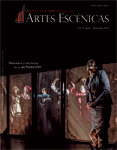Authors
Abstract
The article corresponds to one of the results of the investigation “Digitization of the deprived of freedom body as an act of subversion of the panoptic gaze”, which aims to design a mechanism mediated by the design of digital and virtual interfaces that enable, through experience, undermining the existing gaze of the control and surveillance mechanisms that restrict the freedom and the expression of young people who are paying a “social debt” with the confinement of their bodies. The scope of the research and creation project has allowed enhancing the look people have on the incursions of the digital universe in the process of social rehabilitation of individuals who have been deprived of their liberty. The research methodology has emerged from the work with the population group and their connection with a performative action. It can be concluded, as far as the project has advanced, that the action of the digital body has caused a significant change in the ways young people relate, while leaving a path towards different thoughts about the problem of the body in confinement and in general questioning the practices of power and control to which human beings are subjected.
References
Aicher, O. (1994). El mundo como proyecto.Barcelona: Gustavo Gili.
Brea, J.L. (2010). Las tres eras de la imagen. Madrid: Akal.
Chalmers, D. (2007). La matrix como metafísica. Discusiones Filosófi cas, 11, 209-254.
Debray, R. (1992). Vida y muerte de la imagen.Barcelona: Paidós.
Dorfl es, G. (1972). Naturaleza y artifi cio.Barcelona: Lumen.
Dubois, P. (2000). Vídeo y teoría de las imágenes. En Dubois, P. Video, cine, Godard.Buenos Aires: Libros del Rojas.
Foucault, M. (1984). Las palabras y las cosas.Barcelona: Planeta.
Hansen, M. (2004). Bodies in code: Interfaces with Digiatl Media. New York: Routledge Taylor & Francis Group.
Haraway, D. (1995). Ciencia, cyborgs y mujeres.Madrid: Cátedra.
Herbert, S. (2005). Las ciencias de lo artifi cial.Barcelona: Editorial ATE.
Kac, E. (2005). Telepresence and Bio Art:Networking Humans, Rabbits and Robots. Ann Arbor: University of Michigan Press.
Kepes, G. (1969). El lenguaje de la visión. Buenos Aires: Editorial Infinito.
Levy, P. (2007). Cibercultura. México:Anthropos.
Maldonado, T. (1998). Crítica de la razón informática. Buenos Aires: Paidós.
McLuhan, M. (1994). Understanding Media.Massachusettes: The MIT Press.
Merleau-Ponty, M. (1966). Lo visible y lo invisible. Barcelona: Seix Barral.
________. (1985). Fenomenología de la percepción.Barcelona: Planeta.
Negroponte, N. (1996). Ser digital. Buenos Aires: Atlántida.
Norman, D. (2002). The Design of Future Things:Author of The Design of Everyday Things. USA:Hardcover.
Stelarc. (2012). Carne circulante: el cadáver, el comatoso y la quimera. En Cortés, L.(Ed.), Arte + Máquinas (pp. 39-49). Bogotá:Universidad Distrital.

 PDF (Español)
PDF (Español)
 FLIP
FLIP









